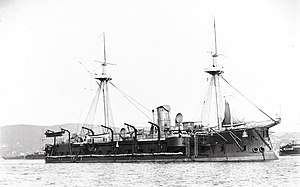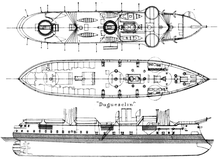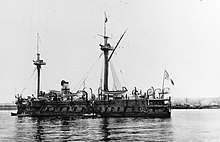Vauban-class ironclad
The Vauban class, sometimes referred to as the Duguesclin class, was a pair of two ironclad barbette ships built for the French Navy in the late 1870s and 1880s. The class consisted of Vauban, the lead ship, and Duguesclin. They were based on the ironclad Amiral Duperré, adopting the same general arrangement, but were scaled down in size. They were intended for use overseas in the French colonial empire, and as such, they retained a sailing rig for long-range cruising and copper sheathing for their hulls to protect them when they would be unable to be dry-docked regularly. They carried a main battery of four 240 mm (9.4 in) guns that were mounted in individual barbettes; two were in sponsons forward, abreast of the conning tower, and the other two were on the centerline aft.
 Duguesclin in port, date unknown | |
| Class overview | |
|---|---|
| Operators: |
|
| Preceded by: | Bayard class |
| Succeeded by: | Terrible class |
| Built: | 1878–1886 |
| In commission: | 1885–1904 |
| Completed: | 2 |
| Scrapped: | 2 |
| General characteristics | |
| Displacement: | 6,112 long tons (6,210 t) |
| Length: | 81 m (265 ft 9 in) lwl |
| Beam: | 17.45 m (57 ft) |
| Draft: | 7.62 to 7.7 m (25 ft 0 in to 25 ft 3 in) |
| Installed power: |
|
| Propulsion: |
|
| Speed: | 14 to 14.5 kn (25.9 to 26.9 km/h; 16.1 to 16.7 mph) |
| Complement: | 440–450 |
| Armament: |
|
| Armor: | |
Despite the Navy's intention to use them overseas, both members of the class served with the Mediterranean Squadron for the majority of their careers, from the 1880s to the mid-1890s. They were occupied with peacetime training exercises, and in 1893, they were reduced to the Reserve Division of the squadron. They were laid up after 1895, and Duguesclin saw no further active service, being struck from the naval register in 1904. Vauban was recommissioned in 1899 for a tour in French Indochina, returning briefly in 1900, before being sent back to East Asia in response to the Boxer Rebellion in Qing China. She was again placed in reserve in Saigon from 1903 to 1905, thereafter being struck from the register. The fates of both vessels are unknown.
Design
The Vauban class of barbette ships, sometimes known as the Duguesclin class, was designed in the late 1870s as part of a naval construction program that began under the post-Franco-Prussian War fleet plan of 1872. At the time, the French Navy categorized its capital ships as high-seas ships for the main fleet, station ironclads for use in the French colonial empire, and smaller coastal defense ships. The Vauban class was intended to serve in the second role, and they were in most respects similar to the preceding Bayard class of station ironclads. Both designs were based on the high-seas ironclad Amiral Duperré, albeit a scaled-down version.[2]
Characteristics

The ships of the Vauban class were 81 m (265 ft 9 in) long at the waterline, with a beam of 17.45 m (57 ft) and a draft of 7.62 to 7.7 m (25 ft 0 in to 25 ft 3 in). They displaced 6,112 long tons (6,210 t). They were fitted with a pair of pole masts equipped with spotting tops for their main battery guns. The ships had a minimal superstructure, with a small conning tower placed between the forward guns. Their hulls were constructed with iron, sheathed in wood and were coppered to protect them from biofouling during extended periods abroad where dry dock facilities were less available. The crew numbered between 440 and 450 officers and enlisted men.[1][3]
Their propulsion machinery consisted of two 3-cylinder compound steam engines with steam provided by eight coal-burning fire-tube boilers that each had two fireboxes. The boilers were ducted into a single funnel directly astern of the conning tower. The engines were rated to produce 4,400 indicated horsepower (3,300 kW) for a top speed of 14 to 14.5 knots (25.9 to 26.9 km/h; 16.1 to 16.7 mph). Coal storage amounted to 400 to 450 long tons (410 to 460 t). To supplement the steam engines, they were fitted with a brig sail rig with a total area of 2,160 m2 (23,200 sq ft). Later in their careers, their sailing rigs were removed and their masts carried only fighting tops.[1][3]
The ships' main battery consisted of four 240 mm (9.4 in), 19-caliber guns mounted in individual barbette mounts, two forward placed abreast in sponsons and two aft, both on the centerline. They carried a 190 mm (7.6 in) gun in the bow as a chase gun. These guns were supported by a secondary battery of six 140 mm (5.5 in) guns carried in an unarmored, central battery located amidships in the hull, three guns per broadside. For defense against torpedo boats, Vauban carried four 47 mm (1.9 in) 3-pounder Hotchkiss revolver cannon and twelve 37 mm (1.5 in) 1-pounder Hotchkiss revolvers, all in individual mounts. Duguesclin instead only carried the 1-pounder Hotchkiss guns. Their armament was rounded out with two 356 mm (14 in) torpedo tubes in above-water launchers.[1]
The ships were protected with wrought iron armor; their belt was 254 mm (10 in) thick amidships, where it protected the ships' ammunition magazines and propulsion machinery spaces, and it tapered to 152 mm (6 in) at the bottom edge. The belt extended for the entire length of the hull, but at the bow and stern, it was reduced to 152 mm. The belt covered the side of the ships from 1.5 m (5 ft) above the waterline to 1.5 m below. An armor deck that was 51 mm (2 in) connected to the top edge of the belt. Compound armor that was 203 mm (8 in) thick was used for the main battery barbettes. The conning tower had 51 mm of iron plate on the sides.[1][3]
Ships

| Name | Builder[1] | Laid down[1] | Launched[1] | Completed[1] |
|---|---|---|---|---|
| Vauban | Arsenal of Cherbourg | February 1879 | July 1882 | 1885 |
| Duguesclin | Rochefort | December 1878 | April 1883[3] | August 1886 |
Service histories
The two ships of the Vauban class served with the Mediterranean Squadron after entering service, though Duguesclin was initially placed in reserve between 1886 and 1888. Through the late 1880s and early 1890s, they took part in the peacetime routine of training exercises with the rest of the fleet. Vauban served as the flagship of the 3rd Division of the squadron in the early 1890s.[4][5][6][7] In 1893, both vessels were transferred to the Reserve Division, where they spent half the year in commission for training maneuvers.[8] Rated as armored cruisers by that time, they spent two years in the unit before newer, purpose-built cruisers took their places. They were then placed out of commission in 2nd category reserve, kept only to be mobilized in the event of war.[9][10]
In 1899, Vauban was recommissioned for a year-long tour in French Indochina, returning to France after having been relieved by the protected cruiser D'Entrecasteaux.[11] Her return to France proved short lived, as the Boxer Rebellion in Qing China prompted the Navy to send Vauban, along with several other warships, back to East Asian waters to reinforce the Eight-Nation Alliance that had formed to defeat the Boxers.[12] After the conflict ended in 1901, she returned to French Indochina, where she spent the next few years in reserve in Saigon,[13][14] before being struck from the naval register in 1905. Duguesclin, meanwhile, was struck the year before and discarded. Their ultimate fates are not known.[1]
Footnotes
Notes
- Only Vauban carried the 47 mm guns.[1]
Citations
- Gardiner, p. 303.
- Ropp, p. 97.
- Brassey 1888b, p. 331.
- Brassey 1888a, pp. 208–213.
- Brassey 1889, pp. 450–451.
- Brassey 1890, pp. 33–36, 64.
- Brassey 1891, pp. 33–40.
- Brassey 1893, p. 70.
- Brassey 1895, p. 51.
- Weyl, p. 96.
- Leyland 1900, p. 65.
- Leyland 1901, pp. 75–77.
- Brassey 1903, pp. 62–63.
- Brassey 1904, p. 90.
References
- Brassey, Thomas, ed. (1888). "French Naval Manoeuvres, 1886". The Naval Annual. Portsmouth: J. Griffin & Co.: 207–224. OCLC 496786828.
- Brassey, Thomas, ed. (1888). "Duguesclin". The Naval Annual. Portsmouth: J. Griffin & Co.: 331. OCLC 496786828.
- Brassey, Thomas (1889). "French Naval Manoeuvres, 1888". The Naval Annual. Portsmouth: J. Griffin & Co.: 230. OCLC 496786828.
- Brassey, Thomas, ed. (1890). "Chapter II: Foreign Manoeuvres". The Naval Annual. Portsmouth: J. Griffin & Co. OCLC 496786828.
- Brassey, Thomas, ed. (1891). "Foreign Maneouvres: I—France". The Naval Annual. Portsmouth: J. Griffin & Co.: 33–40. OCLC 496786828.
- Brassey, Thomas A. (1893). "Chapter IV: Relative Strength". The Naval Annual. Portsmouth: J. Griffin & Co.: 66–73. OCLC 496786828.
- Brassey, Thomas A. (1895). "Chapter III: Relative Strength". The Naval Annual. Portsmouth: J. Griffin & Co.: 49–59. OCLC 496786828.
- Brassey, Thomas A. (1903). "Chapter III: Comparative Strength". The Naval Annual. Portsmouth: J. Griffin & Co.: 57–68. OCLC 496786828.
- Brassey, Thomas A. (1904). "Chapter IV: Comparative Strength". The Naval Annual. Portsmouth: J. Griffin & Co.: 86–107. OCLC 496786828.
- Gardiner, Robert, ed. (1979). Conway's All the World's Fighting Ships 1860–1905. London: Conway Maritime Press. ISBN 978-0-85177-133-5.
- Leyland, John (1900). Brassey, Thomas A. (ed.). "Chapter III: Comparative Strength". The Naval Annual. Portsmouth: J. Griffin & Co.: 63–70. OCLC 496786828.
- Leyland, John (1900). Brassey, Thomas A. (ed.). "Chapter IV: Comparative Strength". The Naval Annual. Portsmouth: J. Griffin & Co.: 71–79. OCLC 496786828.
- Ropp, Theodore (1987). Roberts, Stephen S. (ed.). The Development of a Modern Navy: French Naval Policy, 1871–1904. Annapolis: Naval Institute Press. ISBN 978-0-87021-141-6.
- Weyl, E. (1896). Brassey, Thomas A. (ed.). "Chapter IV: The French Navy". The Naval Annual. Portsmouth: J. Griffin & Co.: 61–72. OCLC 496786828.